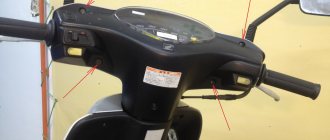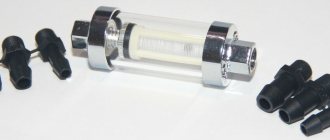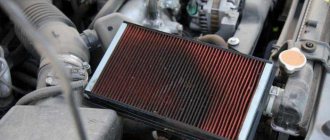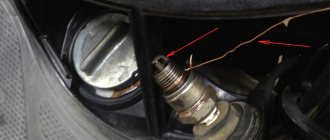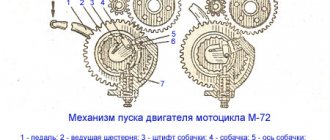Almost all car enthusiasts have a desire to increase the power and dynamics of their car. At the same time, everyone uses their own methods, based on capabilities and level of knowledge.
Some optimize the engine, others install various body kits and spoilers, others use high-quality consumables, and so on.
But experienced car owners know about another popular method - installing a zero-resistance filter.
So what is this device? What are the differences between “nulevik” and standard filters? Is there any point in spending money? Let's figure it out.
Subtleties of the zero resistance filter
We figured out how the zero filter differs from a regular filter, but it’s worth looking at this mechanism in more detail in order to understand why they replace a regular air filter.
Let's start with the fact that the design of the zero-resistance filter is based on a wire frame; to clean the air, either several layers of cotton fabric or foam rubber are used, and such a device is installed only on the injector.
Zero Resistance Filter Parts
Now it’s worth talking about why this detail is needed at all. Nulevik is used when they want to “accelerate” the engine, make the car more powerful, more dynamic, faster. High performance is achieved due to the same throughput of this upgrade. A conventional cleaning system is not capable of transmitting oxygen in such quantities, which cannot be said about this mechanism. After installing it, 40-50% more oxygen begins to enter the injector and then into the engine, which, when burned along with gasoline, releases even more power. When it is installed on the injector, the car’s power increases by an average of 5%, which is quite a significant increase due to such a simple “trinket”.
What is a zero resistance filter for and where is it used?
The task of the air filter installed in each car is to clean the flows entering the engine from various “garbage”. But this is a double-edged sword.
On the one hand, installing a filter allows you to clean the air, and on the other hand, it creates additional resistance to the flow.
The result is a decrease in power, which is especially noticeable as the filter element becomes dirty.
Zero resistance filter is an alternative to the classic filter. The main purpose is to reduce the overall air resistance without compromising the quality of cleaning.
It is believed that installing such a filter can increase engine power by an average of 5-7%. At the same time, there is almost no way to feel the difference from installation. All that remains are facts that you have to believe.
“Nuleviki” are actively used on sports cars with the same purpose - to add power to the power unit. At the same time, any alternatives are not even considered.
But it is worth considering that the difference between sports cars is not only in the installation of a special filter, but also in a more advanced exhaust system, which allows the release of large volumes of exhaust gases even at maximum speed.
What it looks like and how it differs
Zero resistance filter
In its design, the zero resistance filter differs slightly from its analogues, but there are still differences. The fact is that ordinary filters are made of porous paper, and zero filters are made of cotton gauze impregnated with a special lubricant. Ask, what does such an innovation provide, as it is now fashionable to say? Yes, this is elementary: when using such materials and technologies, several times more dust is filtered than with a paper filter.
Please note that this does not mean that it is advisable to use such filters only on sports and/or racing cars. Yes, if desired, exactly the same zero filter can easily be installed in a regular VAZ 2110 or other simple domestic cars and thereby slightly increase their power. In addition, cotton gauze soaked in lubricant not only filters out very small dust particles, but also turns them into “allies”, making them participants in further filtration. In general, you can laugh in the face of all skeptics, because the real filtration efficiency of a zero filter only increases with use.
But there is a point
How to replace the air filter on a Largus. How to change the air filter on a Lada Largus yourself? choosing the right air filter for Largus
There is a common misconception that by removing the filter and housing you can significantly increase engine power. This is completely untrue.
It is important to take into account that when developing an engine, a careful calculation of the valve timing is made, which takes into account errors and losses on the filter. And if dust starts to enter the engine, it will definitely not be able to work for a long time. Here it is necessary to have a fence that will prevent the penetration of contaminants
Resistance can be reduced by widening the passage holes. But then the quality of filtration will decrease
Here it is necessary to have a fence that will prevent the penetration of contaminants. Resistance can be reduced by widening the passage holes. But then the quality of filtration will decrease.
Before looking for a product code and buying a zero for your motorcycle or car, remember one simple truth. For cars without a powerful sports engine, the cost of purchasing such a filter will be absolutely pointless. You will only waste several thousand rubles. The only thing you will get is a slightly changed engine sound.
Nuleviks are only suitable for sports cars and cars with powerful power plants. The use of such a filter on serial engines is allowed only in cases where a comprehensive modification is carried out. That is, boring is done in the cylinders, an enlarged throttle valve is mounted, sports camshafts are installed, etc. You can also put a zero in the kit with them.
How to change it correctly?
How to change the air filter on a Chinese moped? The sequence of actions for replacing the cleaning device in a moped is quite simple.
Instructions for DIY replacement steps:
- First of all, we install the moped on the stand. It is also advisable to wash the moped to prevent dirt from getting into the moped components;
- Now you can start replacing: remove the protective cover of the battery; to do this, you need to unscrew one bolt with a Phillips screwdriver;
- Then we disconnect the battery from the terminals and take it out of the seat;
- Next, you need to remove the seat; to do this, you need to unscrew two bolts with a “10” key and move it with a sharp movement (from left to right in the direction of travel of the moped);
- As soon as the seat has moved, we lift it and it can be easily removed. Pull the clamp off the air filter pipe. If yours is not rubber, but metal, you must first loosen it;
- Now you can pull the pipe off the carburetor. This must be done carefully to prevent dirt from getting inside the carburetor;
- After the pipe has been disconnected from the carburetor, we pull it inward to the place where the battery was. The air filter housing is made of rubberized material, so it can only be deformed when removed, only carefully. While deforming the filter housing, carefully pull it out. This should be done extremely carefully, as you can touch and break the wires passing nearby;
- After successfully removing the casing, remove the filter from it. If there is dust or dirt in the casing, it is necessary to wash and dry it;
- Now install the filter and reassemble in reverse order.
Before installing the seat and battery cover, make sure you have not cut or disconnected any wires during installation.
Nulevik maintenance process
Cabin filter for Lada Granta, replacing the filter yourself. cabin filter Lada Granta. Removing and replacing the grant cabin filter, which is suitable for
To service the zero-resistance filter, there is a special liquid, the treatment of which must also be carried out strictly according to the instructions. That is, there is no standard type circuit removed and installed here
Periodic maintenance is so important that even a slight delay in this matter can make a big difference at the most inopportune moment. This will immediately become noticeable due to a certain engine sluggishness and significant consumption.
So, the cleaning process looks like this:
The filter is removed; Using a soft bristle brush (this is important), carefully clean the entire filter surface, removing all large particles and dirt; A special cleaning liquid is applied to the filter and waited for about 10 minutes until it is completely saturated; The filter is washed in a container with plain water, and then under a weak stream of running water; There is no need to resort to drying the filter; just shake it several times to remove excess water. And even more so, you can’t dry it with heat, so as not to damage it; The filter is installed in place.
Zero resistance filter For normal vehicle operating conditions, filter maintenance is regulated every 10 thousand kilometers. Severe conditions force the maintenance frequency to be doubled, that is, every 5 thousand kilometers. Harsh conditions include frequent trips on dusty roads, regular use of sporty driving at high speeds, as well as the presence of additional tuning elements, for example, a supercharger or turbine installed on the carburetor. In the last two cases, the speed of air intake through the filter is so high that faster contamination of the filter element is possible
Zero resistance filter For normal vehicle operating conditions, filter maintenance is regulated every 10 thousand kilometers. Harsh conditions force us to double the service frequency, that is, every 5 thousand kilometers. Harsh conditions include frequent trips on dusty roads, regular use of sporty driving at high speeds, as well as the presence of additional tuning elements, for example, a supercharger or turbine installed on the carburetor. In the last two cases, the speed of air intake through the filter is so high that faster contamination of the filter element is possible.
Maintenance of zero vehicles
In principle, servicing tuning filters is no different from servicing standard ones. The filter element is cleaned by blowing air in the direction opposite to suction.
There are also types of filters that can be washed. It all depends on the material from which the zero is made. The possibility of washing is usually indicated by the manufacturer. It is necessary to make a reservation that most of the zeros are still disposable. It is impossible to completely wash out dust particles from a heavily soiled filter. Even after thorough purging or washing, its throughput will be lower than that of a new one.
For washable filters, maintenance boils down to rinsing it in water with a detergent solution and then drying it. The manufacturer specifies what exactly to use for washing.
Important: washing the filter with products not recommended by the manufacturer can damage it!
For engines with insufficient power, such a filter is needed
Why is this necessary?
First, let's figure out what it is and what it is eaten with. A standard or regular air filter is designed to clean the air entering the engine from all kinds of contaminants. It is due to air filtration that power loss occurs.
This is due to the fact that the cleaning elements in the filter design (usually special paper) create resistance to air flow. This is not surprising since the filtration material is very dense. And the higher the resistance, the more the final power is lost. As you know, increasing power is achieved by increasing the amount of incoming air. This is where the zero impedance filter comes into play.
Nulevik is an alternative to the standard cleaner. Its design is such that the device reduces intake resistance without sacrificing air purification itself. This results in an increase in power.
And here a logical question arises: is your Priora, VAZ 2112 or VAZ 2114 worthy of such an element? Is it even worth buying a zero car if you want to slightly increase engine power?
Practice and research show that such a small tuning as installing a zero level allows you to get an increase of 3-5% in power. If this is a low-power car, then you definitely won’t feel an increase of several horsepower. You also won't see any difference in dynamics. But the numbers will be higher than you can comfort yourself a little.
Key Benefits
Reading reviews about nuleviks, I came across many conflicting opinions. One installed such a filter on his injector and was very pleased. Another spent a lot of money on a K&N zero and its installation, wanted changes, but in the end all he got was wasted time. And there are many such examples.
I’ll say right away that ordering zero-resistance filters from auto stores is not a problem at all. The price for some models is quite reasonable, so it is not difficult to buy and is relatively inexpensive. But whether such an element needs to be installed on a VAZ with your own hands is an extremely interesting question.
Let's start with the good. Like any device, the Nulevik has its pros and cons. The disadvantages include the cost compared to a conventional air filter and the need for constant cleaning.
As for the advantages, there are several of them.
- Power increases. The nulevik has a complex design that allows it to reduce resistance. This gives an increase in horsepower;
- Simultaneous cleaning efficiency. Although the resistance drops, this does not affect the quality of air purification;
- Replacement frequency. There is no need to change the nulevik as often as a regular filter. They are washable. This allows you to return full performance characteristics;
- Increase in characteristics. Albeit a little, but the zero gear adds power and increases torque;
- Sound. For many, it is not the power that is important, but the sound characteristic of powerful engines. Nulevik creates such an effect, and as a result the car sounds very interesting.
To achieve what you want, you will have to remove the standard filter and install a zero-resistance device in its place. Decide for yourself which is better, buy and install it yourself, or give the car to the experts. In the second case, there will be a guarantee of quality and a well-chosen filter. The main thing is that the specialists themselves are qualified and reliable.
How does a gasoline internal combustion engine work?
Understanding the principles of operation of a gasoline engine will help you understand how the zero-resistance filter affects various modes and conditions of the engine. During the intake stroke, the piston moves towards the crankshaft, a vacuum is formed in the combustion chamber and a ready-made air-fuel mixture enters through the open intake valves. The amount of incoming air depends on the cylinder volume, piston speed (engine speed), valve adjustment, air filter cleaning depth and throttle position.
The higher the engine speed, the stronger the resistance to air movement in the valves, intake manifold turns, and filter. Therefore, the higher the engine speed, the less the cylinders are filled with air (air-fuel mixture). In carburetor engines, there is another element that affects the filling of the cylinders. This is the mixing chamber (diffuser) of the carburetor. Therefore, at high speeds, the power of an injection engine will always be higher than that of a carburetor. All this applies to engine operation in maximum power mode.
In carburetor engines, the amount of incoming fuel directly depends on the carburetor settings and the speed of air movement through the mixing chamber. The principle of operation, a detailed description of the setup and adjustment of this unit, read the article (carburetor). In injection engines, the amount of fuel depends on the controller settings, the state of the injectors, the readings of the mass air flow sensors (MAF), the crankshaft position (CPCV), temperature and other parameters. The tasks of the carburetor and injector are the same - to mix air and fuel efficiently and ensure that the air-fuel mixture matches the engine operating mode.
During the compression stroke, the air-fuel mixture is compressed, after which ignition occurs from the ignition spark and combustion occurs smoothly. The gases released in this case provide sufficient pressure on the piston to turn the crankshaft and transfer the rotational energy first to the gearbox and then to the wheels. There are several engine parameters that are especially important for the car owner:
- fuel consumption;
- power;
- maximum speed.
Fuel consumption is affected by the serviceability and settings of the engine, as well as the condition of the transmission and chassis of the vehicle. Therefore, this parameter can only be improved by correct engine tuning and full serviceability of the car. Engine power affects the maximum speed and acceleration of the car. To increase engine power, both engine tuning and tuning are used, as well as the installation of a zero-resistance filter, which increases the amount of air entering the cylinders. The maximum engine speed depends on the condition and settings of the gas distribution mechanism (GRM), the engine load, the composition of the air-fuel mixture and the filling of the cylinders.
What is a zero and what is it for?
To put it simply, a zero filter is the same air filter and it is designed to clean the air supplied to the cylinders. However, the resistance that the air encounters during the cleaning process is minimized in this type of filter. If we compare the throughput of a nulevik and a standard paper filter, then it will be higher for a nulevik by about 45%, and that’s because conventional filters are based on very dense material. In this case, the engine power directly depends on the incoming resistance. As a result, zero filters increase engine power by approximately 5%. To make it clearer, our beloved VAZ gets about 5 hp. as a bonus. Of course, no one is saying that an additional 5 horses will greatly change the dynamics or will be felt by the driver at all, however, no one is saying that installing only a zero on the carburetor is considered tuning. The carburetor of the sport version requires additional operations to replace jets and improve the throttle valve; even a turbo on the carburetor is installed by individual craftsmen. The design of the zero-resistance filter consists of a frame made of wire, in which there is a filter element made of foam rubber or cotton fabric in several layers. I impregnate the filter element with a special composition for better cleaning and further reduction of resistance.
On which mopeds or scooters should a zero gear be installed?
First of all, such a filter is needed for engines with insufficient power. This category includes:
- spent motors;
- worn-out motors;
- subcompact.
A separate category includes new, powerful equipment, the owners of which strive to achieve maximum speeds. A nulevik on a motorcycle can give it an increase of several km/h to its maximum speed.
In Russia, small mopeds and scooters are extremely popular due to their low cost. Their power is very low, which does not suit the owners very much. A conventional zero-resistance filter installed on the carburetor allows you to compensate for the lack of power.
It is not always advisable to repair heavily worn motors. They are often fitted with new or contract stock (standard) engines. If the owner is already accustomed to increased power, then the standard “stock” characteristics will no longer suit him. To tune such engines, they usually immediately install a zero.
The filter element is cleaned by blowing air
What is a zero resistance air filter
If we exclude the existence of dust in principle and feed the car with the cleanest air, remove all filters and barriers on the way of air to the combustion chamber, then the engine power will increase by 3-5%. This is the price we pay for installing an air filter, but if not for it, the engine would not be able to withstand tens of thousands of kilometers, if not less. It all depends on the operating conditions. Therefore, a filter is still needed.
It is easy to calculate that the increase in power is a miniscule amount. The engine spends much more energy to overcome aerodynamic drag. And its coefficient is greatly increased by ill-conceived body kits, spoilers and fairings. The point is not even in them, but in the fact that the design engineers of sports cars were puzzled by this problem, deciding to make a filter element that would create minimal resistance when sucking in air, and at the same time filter it from abrasive particles. At least for a short time, during the check-in period. The zero resistance filter is a racing car attribute.
The principle of operation of the filter, its features
The operating principle of the “nulevik” is based on two factors:
- high-quality cleaning of the flow entering the motor;
- minimum air resistance.
The effectiveness of the zero resistance filter is due to its unique design and the use of cotton (rather than paper) material.
The incoming flow is filtered from dust without causing any significant contamination to the product. Thanks to special impregnation, particles entering through the filter settle on the surface and do not interfere with the flow of air to the combustion chamber.
As a result, a sufficient volume of air enters the intake manifold, and the power of the power unit increases.
Is it worth installing a zero valve on a carburetor?
Of course, if you are tuning a carburetor, then installing a zero leveler is simply mandatory, because the advantages of using it are obvious:
- Power increases, while the quality of air purification does not deteriorate, which means the engine life ultimately increases;
- The question of regularly replacing the filter with a new one goes away, since the zero filter is simply washed;
- Increases torque at low and medium speeds.
However, the increase in power occurs in the range from 6 to 8%, which is not particularly noticeable on driving dynamics, and shelling out a considerable amount of money at once without resorting to other types of tuning is simply not advisable. Therefore, before you set a zero, think: do you need it?
Installation method
The first thing you need to do when starting to replace a conventional filter with a zero filter is to find a block with wires from the air flow sensor
So we look at the injector, find it and, very carefully, so as not to damage the wires, remove it
Now we look at the air filter housing, it looks like a square box secured with four bolts. It is necessary to unscrew each bolt and remove the top cover. Once the cover is removed, you will see the air filter underneath, pull it out.
Now we completely dismantle the housing of the old cleaning system and remove the mass air flow sensor unit (hereinafter referred to as MAF) from it. You need to remove the clamping ring from the mass air flow sensor unit, the one that was near the old filter, and connect the zero in the same place, while tightening the clamp very tightly around the tube. Now we need to insert the pipe onto which our zero is screwed into the air intake tube and also crimp the whole thing with a clamp.
It would seem that everything is ready, the injector is equipped with a new device that will increase engine performance, but that’s not all, do not forget to secure the filter with the included fasteners.
Installation Features
Many car enthusiasts make a big mistake - they install the “zero” incorrectly, which is why it is not able to perform its functions normally.
For example, the filter is installed too close to a hot engine or exhaust manifold. Here it’s time to remember physics.
The density of cold air is higher than that of hot air. As a result, it is easier to “push” cold air into the combustion chamber than hot air.
Therefore, the “nulevik” should be located as far as possible from any heat sources (motor, exhaust manifold, etc.).
In addition, it is not recommended to install the filter in the lower part of the engine compartment. In such a situation, the product will quickly become dirty and lose its best qualities.
In addition, a dirty filter will have to be “repaired”, which will also take some time.
Today there are a lot of models of zero filters that are designed for installation on various types of cars - with an injector or a carburetor.
The material can be mesh, foam rubber or cotton. Filters made of foam rubber have the highest degree of purification, but they also have more resistance than their “brothers”.
Installation of the “nulevik” on different cars is done differently, but in general you need to follow the following algorithm:
- discard the connector from the MAF (mass fuel flow sensor);
- use a screwdriver to disconnect the rubber tube from the air flow sensor;
- remove the sensor fasteners from the body (to do this you will have to unscrew a couple of bolts);
- dismantle the case and remove the rubber clamps (use duckbills or pliers);
- unscrew the fastener from the group of wires;
- fasten a pair of bolts from the mass air flow sensor clamp to the “zero” fastener;
- Place a new filter on the mass air flow sensor, tighten the clamping clamp and connect the sensor.
That's all, the new filter is installed on the car.
Why is this necessary?
First, let's figure out what it is and what it is eaten with. A standard or regular air filter is designed to clean the air entering the engine from all kinds of contaminants. It is due to air filtration that power loss occurs.
This is due to the fact that the cleaning elements in the filter design (usually special paper) create resistance to air flow. This is not surprising since the filtration material is very dense. And the higher the resistance, the more the final power is lost. As you know, increasing power is achieved by increasing the amount of incoming air. This is where the zero impedance filter comes into play.
Nulevik is an alternative to the standard cleaner. Its design is such that the device reduces intake resistance without sacrificing air purification itself. This results in an increase in power.
And here a logical question arises: is your Priora, VAZ 2112 or VAZ 2114 worthy of such an element? Is it even worth buying a zero car if you want to slightly increase engine power?
Practice and research show that such a small tuning as installing a zero level allows you to get an increase of 3-5% in power. If this is a low-power car, then you definitely won’t feel an increase of several horsepower. You also won't see any difference in dynamics. But the numbers will be higher than you can comfort yourself a little.
Key Benefits
Reading reviews about nuleviks, I came across many conflicting opinions. One installed such a filter on his injector and was very pleased. Another spent a lot of money on a K&N zero and its installation, wanted changes, but in the end all he got was wasted time. And there are many such examples.
I’ll say right away that ordering zero-resistance filters from auto stores is not a problem at all. The price for some models is quite reasonable, so it is not difficult to buy and is relatively inexpensive. But whether such an element needs to be installed on a VAZ with your own hands is an extremely interesting question.
Let's start with the good. Like any device, the Nulevik has its pros and cons. The disadvantages include the cost compared to a conventional air filter and the need for constant cleaning.
As for the advantages, there are several of them.
- Power increases. The nulevik has a complex design that allows it to reduce resistance. This gives an increase in horsepower;
- Simultaneous cleaning efficiency. Although the resistance drops, this does not affect the quality of air purification;
- Replacement frequency. There is no need to change the nulevik as often as a regular filter. They are washable. This allows you to return full performance characteristics;
- Increase in characteristics. Albeit a little, but the zero gear adds power and increases torque;
- Sound. For many, it is not the power that is important, but the sound characteristic of powerful engines. Nulevik creates such an effect, and as a result the car sounds very interesting.
To achieve what you want, you will have to remove the standard filter and install a zero-resistance device in its place. Decide for yourself which is better, buy and install it yourself, or give the car to the experts. In the second case, there will be a guarantee of quality and a well-chosen filter. The main thing is that the specialists themselves are qualified and reliable.
What is a zero and what is it for?
To put it simply, a zero filter is the same air filter and it is designed to clean the air supplied to the cylinders. However, the resistance that the air encounters during the cleaning process is minimized in this type of filter. If we compare the throughput of a nulevik and a standard paper filter, then it will be higher for a nulevik by about 45%, and that’s because conventional filters are based on very dense material. In this case, the engine power directly depends on the incoming resistance. As a result, zero filters increase engine power by approximately 5%. To make it clearer, our beloved VAZ gets about 5 hp. as a bonus. Of course, no one is saying that an additional 5 horses will greatly change the dynamics or will be felt by the driver at all, however, no one is saying that installing only a zero on the carburetor is considered tuning. The carburetor of the sport version requires additional operations to replace jets and improve the throttle valve; even a turbo on the carburetor is installed by individual craftsmen. The design of the zero-resistance filter consists of a frame made of wire, in which there is a filter element made of foam rubber or cotton fabric in several layers. I impregnate the filter element with a special composition for better cleaning and further reduction of resistance.
How to care for such filters?
As already mentioned, one of the main disadvantages of the filter is the need for regular maintenance.
After purchasing and installing the product, it must be washed and treated regularly. In this case, processing according to the “remove-wash-install” principle will no longer work - a special algorithm is required here.
The frequency of washing is every 5-6 thousand kilometers. If the car is operated in dusty areas or off-road, then the filter must be cleaned more often.
If you forget about servicing the device, the machine becomes “gluttonous” and “dumb.”
The algorithm of actions is as follows:
- remove the zero filter from the machine and remove all dust from it using a special brush;
- Wash the unit in a special container with a special cleaning solution, then rinse the filter under water pressure;
- shake off the filter element and inspect it. If there are light spots, the filter needs to be impregnated with a special agent;
- treat the product with a special impregnation (as a rule, it is sold separately from the “nulevik”);
- return the “zero” to its original place.
There are even special kits for caring for “nuleviks”, which include washing and impregnation. A few manipulations as described above, and the product looks like new.
Please note that the total number of washes can be limited and is about 20 pieces. After this, it is worth installing a new filter.
The correct algorithm for installing a zero filter on a VAZ 2109
VAZ 2109 zero resistance filters
Most Lad-Nines are equipped with a carburetor engine, however, there are often models with an injection engine. Objectively, to understand the process, it is necessary to consider separately the installation of a zero filter on cars with a carburetor engine and separately on those with an injection
Points to pay attention to when installing a zero-resistance filter:
- make sure you understand the complete installation process;
- make sure that the filter is firmly fixed;
- follow the exact sequence of the installation algorithm;
- Do not try to upgrade the engine filter yourself.
Installation on the injector
In order to install a zero filter on an injection engine, you first need to separate the flow meter and the standard factory air filter. Only after this can a zero-resistance filter be installed in place of the factory one. Classic fasteners will help you cope with this seemingly difficult task. So, this process looks like this:
- the filter is located at the beginning;
- after it there is a flow meter;
- then gorfa;
- and at the very end is the intake manifold.
Advantages and disadvantages of use
Advantages:
- The main advantage of tuning the air filter (installing a zero filter) is an increase in engine power. This is the most accessible and inexpensive way to get extra “horses” from the engine. Installation does not require any special modifications and can be done independently.
- There are varieties of zero filters that are installed in place of the standard filter, but they are not very effective and often cost more. The most effective models of zero filters do not coincide in size with the standard ones, because they have a large filtering surface. To install them you will have to choose another place.
Increasing engine power is by installing a zero gear
Negative sides:
- One of the difficulties that arises when installing any zero resistance filter is the need to adjust the carburetor. For more air in the cylinder, which is provided by the filter, more fuel is also necessary, because the air-gasoline mixture must be proportional.
- The operation of the carburetor in transient modes (acceleration), when additional enrichment of the mixture is required, is subject to adjustment. If more air is not supplied with more fuel, the engine will lose acceleration dynamics.
- There is one more problem. A real headache for motorcycle owners are low-quality filters. Companies that produce such products simply reduce the density of the filter material instead of increasing the surface area. With a reduced material density, the air actually encounters less resistance, but the filtering effect is also greatly reduced. As a result, dust still gets into the cylinders.
By purchasing a zero-resistance filter from an unknown manufacturer, you risk having to overhaul the engine within a season. Therefore, it is recommended to use zero-resistance filters only from trusted manufacturers.
A zero-resistance filter allows you to avoid problems
What is a nulevik?
A zero-resistance filter for a motorcycle or scooter is a conventional air filter designed to protect the cylinders from dust, but has less resistance to air flow (almost zero). This is achieved by increasing the filter surface area compared to standard filters, which facilitates the passage of air.
A conventional air filter is a zero resistance filter
Why do you need a zero? When the piston moves back, a vacuum is created in the cylinder, and air is sucked into it, mixing with gasoline. The more air that can be sucked into the cylinder, the more combustible mixture there will be for operation and the greater the power. However, a filter gets in the way of the air. It creates resistance to air flow, so less air enters the cylinder than it could.
It is impossible to do without a filter, because any dust entering the cylinder causes severe wear. A zero resistance filter avoids these problems. The engine begins to “breathe deeply” and at the same time has full protection from dust.
The task and main difference between an air filter and a zero filter
What is an air filter for? Everything is very simple, this part provides a better supply of oxygen to the engine, while the intake air is, as far as possible, cleaned of dust and other pollutants, which also has a positive effect on engine operation.
Now let’s figure out what “zero” is. Essentially, it's the same thing, but with zero resistance. This air resistance is achieved due to the fact that this device uses cotton fabric instead of filter paper; it has higher throughput characteristics. This way the injector, and with it the entire engine, receives more oxygen.
Pros and cons of installing in a regular place
But there are many more disadvantages:
- Hidden installation of the filter under the housings prevents full access of air to the filter. For zero engines this is especially critical, because their purpose is lost - to give the engine as much air as possible.
- In addition, installing the filter under the housing requires the use of an air duct, which is a flexible rubber pipe that runs from the filter to the intake manifold, which integrates the intake, carburetor and cylinder.
- Due to the design features, the air duct most often has a curved shape, so the air flow in it changes direction. Passing through such a pipe also creates resistance to flow. To improve performance, a direct-flow filter for the carburetor is best suited. This type of zero does not require an air duct, has open access to ambient air and is the most efficient.
In a regular place or not?
Often, those who think about installing such “nuleviks” have a choice - to install them in the standard place of the air filter or to install them separately, that is, bypassing the standard box. Often, many companies make a separate one, it certainly looks impressive, but is its installation justified? Let's look at each situation:
Separate. That is, without regular placement. According to the manufacturer, these options are the most productive, that is, they are capable of delivering up to 7% of power. YES and they look impressive under the hood. However, there are many controversial issues here, the whole point is that a heated engine has a high temperature, and this element sucks air, so to speak, right on top of the engine, where it is approximately 50 (and in the summer, up to 60) degrees Celsius. The point here is this - the density of hot air is much lower than cold air, so such a filter even loses power, because it supplied hot air - its density at 50 degrees Celsius is 1.109 kg/cm3. Whereas air at 20 degrees has a density of 1.204 kg/cm3. The difference is almost 10%, that’s your increase in power, you will lose even more and the effect of such an element will be negative than positive.
In a regular place. Now they are sold for almost every car, that is, you can throw out the standard one and put a “zero” in your car - square, in general, as we are used to. However, as the manufacturers assure, its performance is lower, that is, it can provide up to 5% of the power. But such a zero-resistance filter has its advantages, namely - the standard air intake system, as a rule, is located either next to the wing or under the engine, where the air is much cooler. Thus, we increase its density (that is, we suck hot from below), rather than from above. It turns out that this is precisely the effect of a 5% increase in power.
That is, the second type, in a regular place, wins in almost all respects.
Installing a zero resistance filter
Tuning a carburetor with the installation of a zero filter always begins with the question of the correct location of the filter itself. If carburetor tuning is limited only to installing one filter, then it is not difficult to do it yourself and the issue of finding a location is not particularly upsetting, because in principle there is enough space. However, additional tuning elements, such as an installed turbine on a carburetor or compressor, in most cases still forces you to remove the filter from the engine compartment, since there is simply not enough space for it. In addition, there is another positive aspect of bringing the filter outside: there are large flows of air with dust in the engine compartment, and this leads to more frequent clogging of the filter. That is, removing the filter from the engine compartment reduces the frequency of filter washings, and therefore saves money.
Advantages and disadvantages of “nuleviks”
As practice shows, such filters have their positive and negative qualities.
Let's start with the pros:
- increase in power by 5-7%. Of course, this may not be noticeable to the driver, but when installed in combination with other types of engine tuning, the result can be felt for yourself;
- changing the sound characteristics of the motor. It is believed that the filter element makes a special sound, which changes the general hum from the engine compartment. Many car enthusiasts install “nuleviks” precisely for this reason;
- The appearance of the space under the hood changes - it becomes more sporty.
Disadvantages of "nulevik":
- the need for constant maintenance, which not all car owners like to do;
- affordable filters are of low quality, so they clog almost immediately. The oil also becomes contaminated faster, which leads to a decrease in the life of the power unit.
What is this detail
A zero-resistance filter, or zero-resistance filter, is an element that, with normal filtering capacity, has too low a degree of resistance.
Every engine is required to be equipped with an air filter. Which ensures air purification before it enters the cylinders. Thanks to this, the motor remains operational for a long time and is protected from sudden breakdowns. However, the standard filter element has a drawback - too high a degree of resistance, due to which the engine loses about 5-7% of power. In order for this power to be maintained, a nulevik is required, which is a compromise between the cleaning element and air throughput.
To make a zero-resistance filter, two types of materials are used:
- cotton fiber;
- large-pored foam rubber.
The second option is characterized by a longer service life.
Structural and functional differences
Depending on their design features, such filters are:
- with impregnation;
- dry, without impregnation.
A filter impregnated with special oil, which reliably envelops the cells in its curtain, is more effective. Made from several layers of fabric and heavily impregnated, it traps dust on the lubricant and provides the engine with an increase in power of up to 7%.
The non-impregnated filter is similar to the standard version, with the exception of the materials used to make it. It is easier to care for, but it provides a smaller increase in power - up to 5%.
There are two filter design options - for a separate and standard location.
A separately placed filter element is considered more efficient and capable of delivering up to 7% of power. But there are some nuances here. This part sucks in air above a heated engine. Its temperature is 50-60 degrees. The density of hot air is approximately 10% lower than the density of cold air. Therefore, engine power may be reduced.
A filter installed in a standard place is preferred by many motorists due to the convenient location of the air intake system - under the engine or near the wing, where its temperature is much lower. The air density increases, resulting in a guaranteed increase in engine power of up to 5%.
Is it possible to make a nulevik with your own hands?
On the Internet you can find a lot of information about making a zero-resistance filter with your own hands. Of course, such filters cannot achieve the transmission efficiency and filtration quality provided by factory products.
The modern nulevik is a high-tech product, and it cannot be assembled in a garage. However, you can make at least a filter with similar parameters yourself. The filter surface area is usually increased by using filters from equipment with a large engine capacity (cars). The point is to connect the carburetor and the large aftermarket filter without allowing contaminated air to be sucked in at the connection. There is a lot of information about such alterations and you can easily find it on the Internet.
How to make a zero filter with your own hands?
Some car enthusiasts, in a desire to save money, decide to make a “nulevik” with their own hands.
The source is a factory round filter, which was once installed on Moskvich cars.
To make a “nulevik” you can use different methods. We will describe one of them below.
You will need available tools (foam rubber, sealant, sharp knife, glue and others). The total price of the issue is no more than 3-4 US dollars.
It’s worth noting right away that a converted “zero” is unlikely to add power to your car. The reason is outdated technologies that were used in the production of cars in the 70-80s.
When creating filters, manufacturers thought little about the importance of cleaning, so old products only retain very large pieces of dirt. So, by “creating” a zero filter, you are taking a certain risk and can “kill” your engine.
By the way, the only car where such a zero filter would be “at home” is the Moskvich. At the same time, there are owners who immediately cut off the walls to eliminate excess flow resistance.
If you decide to experiment, the sequence will be as follows:
- remove the standard device;
- Make a rectangular adapter with a hole from a piece of plywood.
Drill four more holes and fix the adapter to the air meter sensor.
Before doing this, install a piece of pipe into the hole and treat the cracks with sealant;
- Make additional holes in two plywood circles. At the same time, make a hole of a larger diameter on the outer circle, and on the inner circle (installed near the air meter) - according to the diameter of the pipe being installed. The latter shrinks using sealant;
- make 3 bars with a length of about 16-18 centimeters and use them to fasten the circles. The result will be a unique cylindrical shape. Since there is no plywood in the bars, it is necessary to make holes along the edges for installing self-tapping screws (otherwise the plywood may be damaged);
- To prevent the foam from falling out, make a body. To make it, you can take a mesh for GVL joints. The advantage is the presence of a sticky base, which allows for immediate fixation;
- then foam rubber is glued on the outside using thermosealant, which allows you to securely and quickly fix the device;
- fix a couple of pieces of foam rubber for the side of the barrel with sealant;
- put on foam rubber and fasten the plywood beams with ties.
There are simpler solutions.



